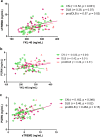Different pattern of CSF glial markers between dementia with Lewy bodies and Alzheimer's disease
- PMID: 31127154
- PMCID: PMC6534578
- DOI: 10.1038/s41598-019-44173-8
Different pattern of CSF glial markers between dementia with Lewy bodies and Alzheimer's disease
Abstract
The role of innate immunity in dementia with Lewy bodies (DLB) has been little studied. We investigated the levels in cerebrospinal fluid (CSF) of glial proteins YKL-40, soluble TREM2 (sTREM2) and progranulin in DLB and their relationship with Alzheimer's disease (AD) biomarkers. We included patients with DLB (n = 37), prodromal DLB (prodDLB, n = 23), AD dementia (n = 50), prodromal AD (prodAD, n = 53), and cognitively normal subjects (CN, n = 44). We measured levels of YKL-40, sTREM2, progranulin, Aβ1-42, total tau (t-tau) and phosphorylated tau (p-tau) in CSF. We stratified the group DLB according to the ratio t-tau/Aβ1-42 (≥0.52, indicative of AD pathology) and the A/T classification. YKL-40, sTREM2 and progranulin levels did not differ between DLB groups and CN. YKL-40 levels were higher in AD and prodAD compared to CN and to DLB and prodDLB. Patients with DLB with a CSF profile suggestive of AD copathology had higher levels of YKL-40, but not sTREM2 or PGRN, than those without. T+ DLB patients had also higher YKL-40 levels than T-. Of these glial markers, only YKL-40 correlated with t-tau and p-tau in DLB and in prodDLB. In contrast, in prodAD, sTREM2 and PGRN also correlated with t-tau and p-tau. In conclusion, sTREM2 and PGRN are not increased in the CSF of DLB patients. YKL-40 is only increased in DLB patients with an AD biomarker profile, suggesting that the increase is driven by AD-related neurodegeneration. These data suggest a differential glial activation between DLB and AD.
Conflict of interest statement
The authors declare no competing interests.
Figures




Similar articles
-
Plasma biomarkers of amyloid, tau, axonal, and neuroinflammation pathologies in dementia with Lewy bodies.Alzheimers Res Ther. 2024 Jul 3;16(1):146. doi: 10.1186/s13195-024-01502-y. Alzheimers Res Ther. 2024. PMID: 38961441 Free PMC article.
-
Glial activation and inflammation along the Alzheimer's disease continuum.J Neuroinflammation. 2019 Feb 21;16(1):46. doi: 10.1186/s12974-019-1399-2. J Neuroinflammation. 2019. PMID: 30791945 Free PMC article.
-
Early microglial and astrocyte reactivity in preclinical Alzheimer's disease.Alzheimers Dement. 2025 Aug;21(8):e70502. doi: 10.1002/alz.70502. Alzheimers Dement. 2025. PMID: 40747577 Free PMC article.
-
Neurodegeneration and Glial Activation Related CSF Biomarker as the Diagnosis of Alzheimer's Disease: A Systematic Review and an Updated Meta- analysis.Curr Alzheimer Res. 2022;19(1):32-46. doi: 10.2174/1567205018666211208142702. Curr Alzheimer Res. 2022. PMID: 34879804
-
Diagnostic value of Alzheimer's biomarkers in cerebrospinal fluid in dementia with Lewy body.Geriatr Psychol Neuropsychiatr Vieil. 2018 Jun 1;16(2):174-180. doi: 10.1684/pnv.2018.0731. Geriatr Psychol Neuropsychiatr Vieil. 2018. PMID: 29877185 Review. English.
Cited by
-
Trisomy 21 activates the kynurenine pathway via increased dosage of interferon receptors.Nat Commun. 2019 Oct 18;10(1):4766. doi: 10.1038/s41467-019-12739-9. Nat Commun. 2019. PMID: 31628327 Free PMC article.
-
Which neuroimaging and fluid biomarkers method is better in theranostic of Alzheimer's disease? An umbrella review.IBRO Neurosci Rep. 2024 Feb 29;16:403-417. doi: 10.1016/j.ibneur.2024.02.007. eCollection 2024 Jun. IBRO Neurosci Rep. 2024. PMID: 38497046 Free PMC article. Review.
-
Biomarkers of blood-brain barrier and neurovascular unit integrity in human cognitive impairment and dementia.Alzheimers Dement. 2025 Mar;21(3):e70104. doi: 10.1002/alz.70104. Alzheimers Dement. 2025. PMID: 40145342 Free PMC article. Review.
-
Cerebrospinal Fluid YKL-40 and Neurogranin in Familial Alzheimer's Disease: A Pilot Study.J Alzheimers Dis. 2020;76(3):941-953. doi: 10.3233/JAD-191261. J Alzheimers Dis. 2020. PMID: 32568193 Free PMC article.
-
Biomarkers of Dementia with Lewy Bodies: Differential Diagnostic with Alzheimer's Disease.Int J Mol Sci. 2022 Jun 7;23(12):6371. doi: 10.3390/ijms23126371. Int J Mol Sci. 2022. PMID: 35742814 Free PMC article. Review.
References
Publication types
MeSH terms
Substances
LinkOut - more resources
Full Text Sources
Medical
Miscellaneous

